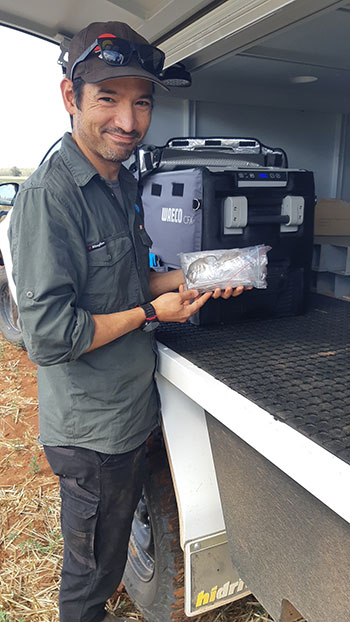An abundance of food following bumper grain seasons can often be a catalyst for mouse plagues, but mitigating the effects of mice on grain production is not simple. It is contingent on understanding how pest populations are structured across the landscape, how far and from where mice are moving and the extent to which geographic features facilitate or impede mouse movement.
Dr Kevin Oh is an evolutionary ecologist based at Macquarie University Applied BioSciences and CSIRO. He brings a particular skill set to investigating the life and habits of mice in Australian landscapes to better inform management practices.
“Better forecasting should improve farmers’ ability to prepare for impending mouse plagues. But this research also aims to understand how mice are moving through the landscape and, in particular, how different landscape features might impede or facilitate mouse movement,” Dr Oh says.
“As an example, we might be interested to know if adjacent bushland or pasture makes it easier or harder for mice to move between paddocks.”
 Dr Kevin Oh capturing mice for genome sequencing to inform potential plague forecasting via improved knowledge of population genetic structure and mouse movement. Photo: Peter Brown, CSIRO
Dr Kevin Oh capturing mice for genome sequencing to inform potential plague forecasting via improved knowledge of population genetic structure and mouse movement. Photo: Peter Brown, CSIRO
With a keen interest in genetics and genomics, local adaptation and conservation biology, Dr Oh applies concepts from evolutionary biology and population genetics along with modern whole-genome sequencing and bioinformatic analyses to address problems in invasive species management.
He has applied these primarily in wildlife conservation and development of new biocontrol techniques, in both vertebrate and invertebrate animal systems.
Genetic tools
He explains that advances in modern DNA sequencing techniques have made it possible to address such questions across broad geographic scales at the whole-genome level. This enables the resolution of fine-scale population genetic structure and gene flow, and may also provide insights into functional genetic variation that could inform the development of future control measures.
In this project, Dr Oh is utilising whole-genome sequencing to identify genetic boundaries among mice sampled at long-term monitoring sites in cereal cropping regions.
“We have obtained DNA from hundreds of mice from sites in New South Wales, Victoria and South Australia, with plans for more sampling this spring in areas of NSW and Queensland impacted by recent plagues. In addition, we have developed new streamlined laboratory protocols for rapid and cost-effective genetic assays to support future mouse monitoring efforts.
“Preliminary analyses indicate only weak genetic differentiation among mice in different cropping regions, suggesting mouse populations are likely to be frequently interconnected.”
Ongoing work aims to understand the extent to which these connections may contribute to mouse population fluctuations. This knowledge will contribute to improving the next generation of mouse plague forecasting.
Dr Oh says the genomic database being built could also be used in the future to develop new direct control methods – for example rodenticides or genetic biocontrol technologies.
His research has crossed domains from working in conservation and natural resource management as a scientist with the US Geological Survey and the US Department of Agriculture to applying his expertise in agricultural production systems. But he has maintained a specific focus on invasive pest species.
“I am keen to continue developing new tools and resources to support efficient and effective management of invasive pest species. It is my hope that this GRDC-supported work will form a key basis for the next generation of pest management strategies.”
More information: Dr Kevin Oh, 0476 145 696, kevin.oh@csiro.au

























































